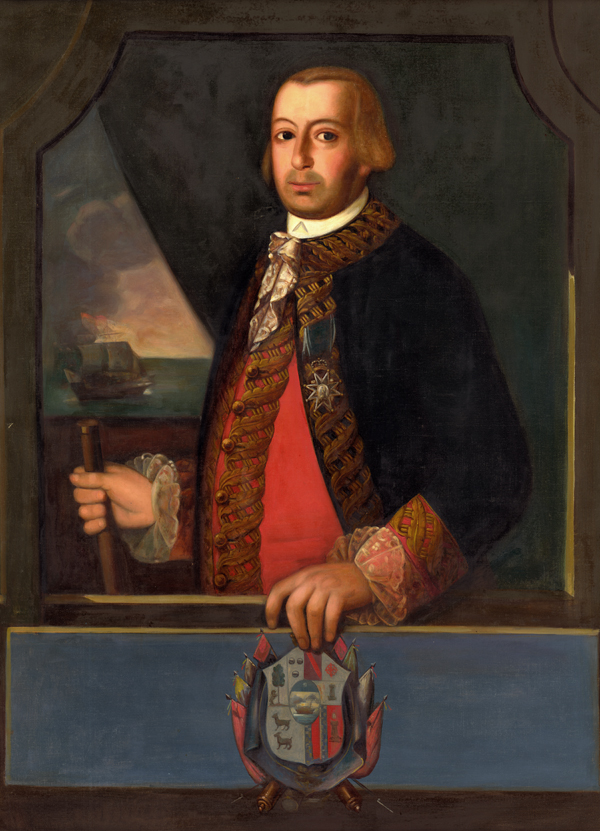Bernardo de Gálvez
Bernardo de Gálvez, the fourth governor of Spanish Louisiana, is best known for leading Louisiana militiamen against the British during the American Revolution.

Courtesy of Louisiana State Museum
Bernardo de Gálvez. Unidentified
Bernardo de Gálvez, the fourth governor of Spanish Louisiana, is best known for leading Louisiana militiamen against the British during the American Revolution. For his military success, especially in defeating the British at Mobile and Pensacola, King Carlos III promoted Gálvez to lieutenant general, named him governor of West Florida and Louisiana, and made him a count.
Born on July 23, 1746, in the province of Málaga, Spain, to Matías and Josepha Madrid y Gallardo de Gálvez, the young Bernardo followed in the footsteps of many family members by training for a military career. Prior to arriving in Louisiana, Gálvez served as a lieutenant in Spain’s war with Portugal and as a captain in the Regiment of Corunna. He joined his uncle, José de Gálvez, on a trip to New Spain in 1768, whereupon he assumed command of expeditions against the Apaches in the areas of Nueva Vizcaya and Sonora. He left New Spain in 1772, studied military science in France for several years, served with Alejandro O’Reilly in a failed attack against Ottomon forces in Algiers, and accepted a commission as colonel of a regiment bound for Louisiana in 1776.
Soon after his arrival in Louisiana, the Spanish Crown issued a royal order on September 19, 1776, instructing Gálvez to replace Luis de Unzaga y Amezaga as governor of Louisiana. Gálvez, then thirty-one years old, officially assumed the governorship on January 1, 1777. That same year, he married Félicité de St. Maxent d’Estréhan, a native of Louisiana and the widow of Jean Baptiste Honoré d’Estréhan, with whom he would have one son and two daughters. Census data collected soon thereafter indicated that the population of Louisiana included 8,381 whites, 273 free mulattoes, 263 free Blacks, 545 enslaved mulattoes, and 8,464 enslaved Blacks. The new governor was quick to enforce antismuggling laws against the British and encourage new legislation that permitted Louisiana colonists to trade with France and the French colonies. He also oversaw Spain’s plan to encourage European immigration and the importation of enslaved Africans to Louisiana in order to facilitate economic growth.
By 1779, 1,582 immigrants from the Canary Islands, now known as Isleños, had established residency along the Mississippi River, in communities stretching from New Orleans to Baton Rouge. A small number of English and American refugees affected by the ongoing war between the United States and Great Britain settled at the confluence of the Amite River and Bayou Manchac; they named the site Galveztown. An additional five hundred immigrants from Málaga, Spain, settled in what would become New Iberia in 1779.
In addition to his domestic duties, Gálvez actively participated as an agent against British interests in the Mississippi Valley and Gulf of Mexico. Instructed by the Crown to aid the American cause, Gálvez provided military leaders such as George Washington, George Rogers Clark, and James Willing with military supplies. He blocked the British from accessing the port of New Orleans and freely navigating the Mississippi River. He corresponded with American political leaders such as Patrick Henry, Thomas Jefferson, Charles Henry Lee, George Gibson, and Oliver Pollock, and went to great lengths to reinforce Louisiana’s military personnel and fortifications.
When Spain formally declared war against Great Britain on June 21, 1779, Gálvez received orders “to direct all our efforts… to drive the British forces out of Pensacola, Mobile, and the other posts they occupy on the Mississippi.” With the assistance of Juan Antonio Gayarré, his commissary of war, Gálvez planned for a series of military expeditions against nearby British posts. He led successful attacks against the British at Manchac, Baton Rouge, and Natchez with forces that included people of French, Spanish, Acadian, African, Native American, Swiss, German, and Mexican descent.
In 1780, with the British neutralized in the immediate vicinity of New Orleans, Gálvez led more than one thousand men against British fortifications at Mobile. The British commander of Fort Charlotte at Mobile surrendered to Gálvez on March 14, 1780, after a siege that lasted more than a month and involved both land and naval operations. A year later, after negotiating for reinforcements with Spanish officials in Havana, Gálvez embarked on another land-sea expedition against the British, this time aimed at the much more formidable Fort George at Pensacola. With more than seven thousand men under his command, Gálvez laid siege to Fort George in March and formally accepted British surrender on May 10, 1781.
Aside from a short-lived rebellion in Natchez, the Spanish conducted no more military campaigns against the British in Louisiana for the remainder of the American Revolution. Gálvez, however, left Louisiana for Havana in August 1781, where he coordinated with French forces to plan attacks against British posts in Jamaica. He organized an assault that captured New Providence, a British naval station in the Bahamas, in May 1782, before leaving for Spain. Gálvez returned to Cuba in October 1784, having been appointed captain-general of Cuba and having retained his title as governor of Louisiana. Upon the death of his father, Matías de Gálvez, the Crown named Bernardo de Gálvez viceroy of Mexico. He died there from a fever on November 30, 1786.
